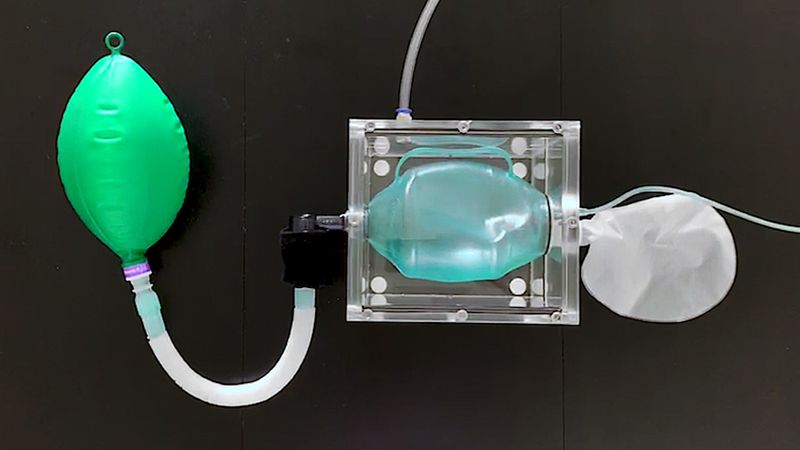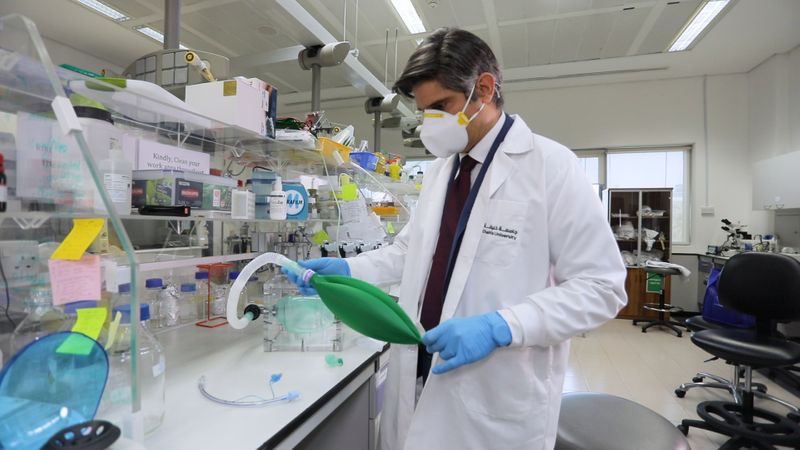
Abu Dhabi: The UAE currently has enough ventilators to tend to critical COVID-19 patients, a top researcher at a UAE-based university has confirmed today (April 22).
“There are currently more than 2.5 million active cases of coronavirus globally, and about 50,000 of them are in critical condition. These are the patients who will require ventilation, meaning about two per cent of the ones infected, while the rest may just need some oxygen support,” said Dr Cesare Stefanini director at the Khalifa University’s Healthcare Engineering Innovation Center and professor of biomedical engineering.
“Usually, there is one ventilator to each intensive care bed. In developed countries that follow best practice, there are 10 to 30 intensive care beds per 100,000 population. On the other hand, only 0.7 per cent of COVID-19 patients in the UAE are known to be critical, so ventilator provision is not an issue here,” Dr Stefanini told Gulf News.
He was speaking during an online seminar about the role of ventilators for COVID-19 treatment, and methods to construct low-cost machines to treat an increasing number of patients.
What is a ventilator?

Ventilator numbers have been in focus during the coronavirus pandemic because these machines provide respiratory support to severely affected coronavirus patients.
The initial treatment pathway for patients who contract coronavirus includes supportive medication and supplemental oxygen for patients. This supplemental oxygen can be delivered through face masks in a non-invasive manner, and is used for mild or moderately affected patients.
But if the immune system cannot rally and beat the infection, the virus causes lung damage, lowering the patient’s oxygen levels and leading to shortness of breath. A ventilator is then used to push air, with increased levels of oxygen, into the oxygen, and patients are given medication to relax respiratory muscles so breathing can be fully regulated by the machine.
Other more invasive ventilators are used for severe cases, and patients may be intubated in order to deliver the air directly into a patient’s airways. The healthcare provider will insert an endotracheal tube (ET tube) through the patient’s nose or mouth and into their windpipe (trachea). This tube is then connected to the ventilator.
The endotracheal tube and ventilator do a variety of jobs. The ventilator pushes a mixture of air and oxygen into the patient’s lungs to get oxygen into the body. The ventilator can also hold a constant amount of low pressure, called positive end-expiratory pressure (PEEP), in order to keep the air sacs in the lung, called alveoli, from collapsing. The endotracheal tube allows doctors and nurses to remove mucous from the windpipe by suction. Finally, the machine eases breathing when a patient cannot naturally contract muscles to breathe in air.

Dr Stefanini said ventilators are expensive equipment that cost between $30,000 (Dh110,000) to $50,000 each.
“Because the number of cases is on the increase, there is a need for such assistive technologies. They are produced in sufficient number during normal circumstances, [but things are different now]. This is why we have seen so many global efforts to develop low-cost ventilators, including crowdfunded initiatives in Europe” he explained.
In addition, many companies from other sectors have stepped up to produce these machines, including electronic consumer goods producer Dyson, as well as Ford, GE and 3M.
When developing ventilators, producers need to ensure that they control the number of breaths per minute provided by the machine, the pressu of deliver air, the amount of air delivered (tidal air), and the ratio of time allocated for inspiration and expiration.
Khalifa University has already developed a prototype for a low-cost ventilator, and according to Dr Stefanini, it should be in production within a few months, pending regulator certification and clinical trials.
“We are setting up a factory to mass produce these ventilators, and our target is for an initial number of 20,000 at the rate of 200 to 300 units per day. Under these assumptions, the machine should cost about $500 (Dh1,836),” he said.
The model will also be shared openly to allow other developers to construct it if needed to enhance local supplies.
In the prototype, a balloon-like manual resuscitator is enclosed in a transparent box. Air is introduced at a controlled pressure into the box. This air squeezes the air inside the resuscitator, delivering it to the patient. Another tube inside the box then collects the air breathed out by the patient. A device is also used to add oxygen to the air delivered to the patient, if required.
“We plan to include mechanisms to clean the air that is delivered to patients. There is also a filter to clean the expired air, but we want to increase the filtration given the infectious nature of this virus. We also hope to include interactive features in order to better ‘listen’ to patients and extract data like fatigue, heartbeat and myographic signals,” Dr Stefanini said.
The prototype also includes removable components that are easily available and therefore replaceable if the same machine has to later be used for more than one person.








